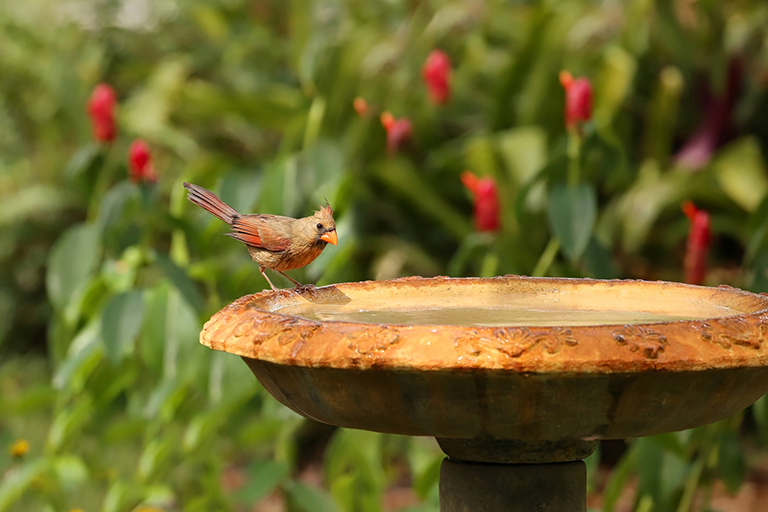By Vicki Spencer, Master Gardener
In February, National Geographic reported that wildlife scientist John Marzluff completed a 12-year study that contributes to our knowledge of how urbanization affects the dispersal of songbirds. His research indicates that some species that avoid urbanized areas, such as Wilson’s warbler, are in decline. Marzluff concludes that the best way to protect these avoider species is to preserve their native habitat. His study also identifies species that managed to adapt to living with humans. Even though development is inevitable, we can help adaptor species by creating landscapes to attract them.
If you live near a stream, open space or forest, chances are you already have a variety of songbirds that visit your yard. But you can attract even more birds in our semiarid climate simply by adding a water feature to your garden. It’s important to keep the water clean to avoid the transfer of disease and to keep the water from freezing in the winter.
In addition to needing water, birds need food, such as seeds, berries, nectar or insects, to survive. As much as I want to keep feeders in my yard, I find it difficult with so many birds visiting. Since I prefer gardening to maintaining feeders, I planted a variety of bushes, trees and flowers that produce bird food naturally.
I am particularly fond of native plants, which are more insect and disease resistant than nonnative species and often require less water. Some native grasses for those living on the eastern plains are prairie coneflower with seed heads that attract finches; little blue-stem, which is a good winter seed source; and hawthorne and hackberry, which produce fruit that birds enjoy. If you live in a pinon-juniper woodland area, you could plant Indian ricegrass, needle-and-thread grass, and silvery lupine for their seeds and Oregon grape and Rocky Mountain juniper for their berries. Higher up in the ponderosa pine regions, big bluestem will provide winter seeds for birds, and scarlet gilia will attract hummingbirds after winter is over. Gardens in semidesert areas could include Idaho fescue, arrowleaf balsamroot and silvery lupine for their seeds.
Finally, birds need shelter to survive. If you live in an area without trees, you can set out nest boxes or plant fast-growing shrubs. The type of shelter you provide will determine which species are drawn to your yard. One of the most popular commercial nest boxes is a bluebird house. Although bluebirds are well-known for nesting in man-made houses, they will not necessarily nest in every one. This is because location is extremely important. Man-made shelters need to mimic the habitat where birds naturally build their nests. Bluebirds often choose to nest in birdhouses hanging on fence posts along ranch and farmland because they prefer open space with perches for hunting insects. Other birds, such as tree swallows, violet-green swallows, ash-throated flycatchers and house wrens, might also build nests in the bluebird boxes.
If you have a small, enclosed yard, you might want to try birdhouses designed to attract nuthatches, wrens or warblers. Some species, such as purple martins, like to nest in groups, so their houses should have at least four rooms. Other species, like robins and phoebes, prefer nesting shelves rather than enclosed boxes. Remember, it takes time to attract birds to new homes, sometimes up to a year or more.
You can also provide shelter by planting trees and shrubs. In the mountains, aspen trees provide good nesting spots for woodpeckers and swallows, and shrub mountain spiraea provides good shelter for other birds. In semidesert regions, you might plant big sagebrush for western meadowlarks and sage sparrows.
Because each of Colorado’s zones is characterized by different native plants, each zone will tend to attract different bird species that depend on the zone-specific plants for food and shelter.
For more ideas on what natives to plant in your area, contact the experts at the Colorado State University Extension, Bureau of Land Management, Natural Resources Conservation Service or the Forest Service.
Gardener Vicki Spencer has an eclectic background in conservation, water, natural resources and more.

